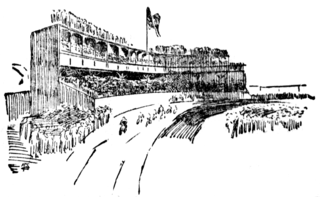
Recreation Park was a sporting grounds and stadium that stood from 1865 to 1905 in Allegheny City,Pennsylvania, which was annexed in 1907 and became the North Side region of Pittsburgh. The park was bounded by Allegheny Avenue, Pennsylvania Avenue, Grant Avenue, and Boquet Street.
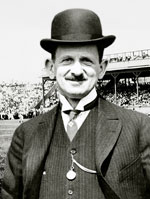
Bernhard "Barney" Dreyfuss was an executive in Major League Baseball who owned the Pittsburgh Pirates franchise from 1900 to his death. He was inducted into the National Baseball Hall of Fame in 2008.
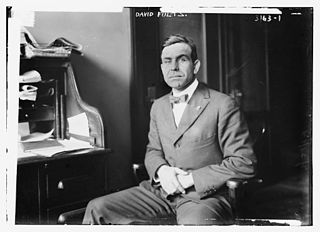
David Lewis Fultz was an American football and baseball player and coach. He played Major League Baseball as a center fielder in the National League with the Philadelphia Phillies (1898–1899) and Baltimore Orioles (1899), and for the Philadelphia Athletics (1901–1902) and New York Highlanders (1903–1905) of the American League. He batted and threw right-handed. In a seven-season career, Fultz posted a .271 batting average with 223 RBI and three home runs in 644 games played. Fultz played college football and college baseball at Brown University, from which he graduated in 1898. He served as the head football coach at the University of Missouri (1898–1899), Lafayette College (1902), Brown (1903), and New York University (1904), compiling a career college football coaching record of 26–19–2. Fultz was also the head baseball coach at the United States Naval Academy in 1907 and at Columbia University from 1910 to 1911.
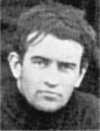
Arthur Poe was an American football player and businessman, and one of six celebrated Poe brothers—second cousins, twice removed, of American author Edgar Allan Poe—to play football at Princeton in the late 19th and early 20th century. He was selected retroactively by the Helms Athletic Foundation as the national college football player of the year for 1899, and was elected to the College Football Hall of Fame in 1969.

Harry Clay Pulliam was an American baseball executive who served as the sixth President of the National League. He served from 1903 until his death in 1909. He was president during the period in which the National League and the fledgling American League settled their hostilities and formed a National Agreement which led to the creation of the World Series.
The Greensburg Athletic Association was an early organized football team, based in Greensburg, Pennsylvania, that played in the unofficial Western Pennsylvania Professional Football Circuit from 1890 until 1900. At times referred to as the Greensburg Athletic Club, the team began as an amateur football club in 1890 and was composed primarily of locals before several professional players were added for the 1895 season. In 1894 it was discovered that the team had secretly paid formerly Indiana Normal player, Lawson Fiscus, to play football and retained his services on salary. The team was the chief rival of another early professional football team, the Latrobe Athletic Association.
The Pittsburgh Stars or Pittsburg Stars were a professional American football team based in Pittsburgh, Pennsylvania that were only in existence for one season in 1902. The team was a member of what was referred to as the first National Football League, which has no connection with the National Football League of today. The whole league was a curious mixture of baseball and football. The Stars were managed and funded, on paper, by Dave Berry, the manager of the professional Latrobe Athletic Association. However, the team was suspected of being secretly financed by the Pittsburgh Pirates. During 1902, the league's only year in existence, the Stars won the league championship, beating out two teams that were financed by the owners of baseball's Philadelphia Athletics and the Philadelphia Phillies.
The first National Football League (NFL) was the first attempt at forming a national professional American football league in 1902. This league has no ties with the modern National Football League. In fact the league was only composed of teams from Pennsylvania, which meant it was actually regional, despite having locations in the two largest cities in Pennsylvania. Two of the teams were based in Philadelphia, while the third was based in Pittsburgh. This NFL was a curious mixture of football players and baseball players who adapted to playing football. Future Baseball Hall of Famer Rube Waddell was with the Philadelphia Athletics, and pitcher Christy Mathewson a fullback for Pittsburgh. Two of the three teams were owned by the Philadelphia Phillies and Philadelphia Athletics, with the third team suspected of being owned by the Pittsburgh Pirates. The league folded after the 1902 season.
The Philadelphia Phillies were a professional American football team based in Philadelphia, Pennsylvania in 1902. The team was a member of what was referred to as the National Football League—not to be confused with the National Football League of today. The whole league was a curious mixture of football players as well as baseball players who adapted to playing football. The Phillies were owned and financed by baseball's Philadelphia Phillies just as the owners of the Philadelphia Athletics financed their team, the Philadelphia Athletics. The Pittsburgh Stars made up the third team and was suspected of being financed by the Pittsburgh Pirates baseball team.

Frederick Joseph Crolius was an American football and baseball player and coach. He was the first player from Tufts University to play Major League Baseball. He was at Tufts in 1894, and at Dartmouth College, where he also played college football, from 1896 until 1899. He spent two years in majors with the Boston Beaneaters and the Pittsburgh Pirates. Crolius also played pro football with the independent Homestead Library & Athletic Club and the Pittsburgh Stars of the first National Football League. He later served as a coach of both sports after his playing career ended.
The Franklin Athletic Club was an early professional football team based in Franklin, Pennsylvania. It was considered the top team in professional football in 1903, by becoming the US Football Champions and winning the 1903 World Series of Football, held after the 1903 season, at New York's Madison Square Garden. The team was also the rivals to the nearby Oil City Athletic Club.
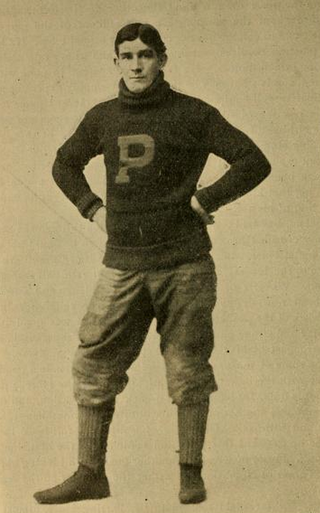
Peter Delome Overfield was an All-American and professional football player, federal judge and rancher. Overfield played center for the University of Pennsylvania and was a first-team All-American in 1898 and 1899. He served as a federal district judge in Alaska from 1909 to 1917. In 1917, he moved to Casa Grande, Arizona where he lived for the remainder of his life, owning a large ranching operation.
The 1900 Homestead Library & Athletic Club football team won the professional football championship of 1900. The team was affiliated with the Homestead Library & Athletic Club in Homestead, Pennsylvania, near Pittsburgh. The team featured a lineup of former college All-Americans paid by Pittsburgh Pirates' minority-owner William Chase Temple.
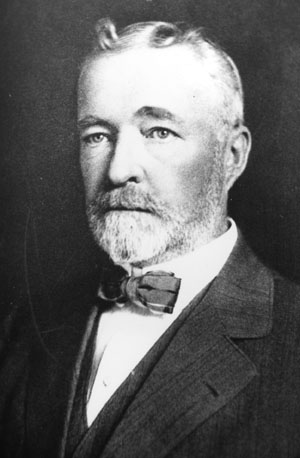
William Chase Temple was a coal, citrus, and lumber baron during the late 19th and early 20th centuries. He was also a part owner of the Pittsburgh Pirates in Pittsburgh, Pennsylvania from baseball's National League of Professional Baseball Clubs, established 1876. He also established the Temple Cup, a silver trophy awarded to the winner of a best-of-seven, post-season Major League Baseball championship series that was conducted for four seasons in the National League, from 1894 to 1897. He became the first sole owner of a professional American football team, in 1898.
Charles Robert "Bob" Shiring was a professional football player from Pittsburgh, Pennsylvania. He began his playing career with the Pittsburgh Athletic Club during the late 1890s and the Homestead Library & Athletic Club in 1901. In 1902, he played for the Pittsburgh Stars of the first National Football League, who ended up winning the league title. Since the Stars consisted of the best professional players from western Pennsylvania at the time, it can be said that Shiring was considered the best at his position, center, in the region. However Shring is best known for playing for the Massillon Tigers from 1903 until 1907. He finally served from 1907 to 1909 as a player-coach for the Pittsburgh Lyceum, Pittsburgh's last championship professional football team, until the 1970s.
Willis Richardson was an early professional football player-coach for the Homestead Library & Athletic Club and the Pittsburgh Stars of the first National Football League. He won the Western Pennsylvania State Championship with Homestead in 1900 and 1901. Then in 1902, he brought along many former Homestead players to the Stars team, which was formed by the former Latrobe Athletic Association manager, Dave Berry, and probably funded by the Barney Dreyfuss and William Chase Temple of the Pittsburgh Pirates baseball team. During the Stars "championship game" against the Philadelphia Athletics, Willis scored an extra point to help lead the Stars to an 11–0 victory and the 1902 championship.

David J. Berry was an American football manager during the late 19th and early 20th centuries. He was the top promoter for the sport during that time period. He is credited with inventing the "all-star game concept" in 1898, and also helped to form one of the first organized football leagues in 1902.
Hawley Pierce was an early professional football player for the Philadelphia Athletics of the first National Football League and later for the Syracuse Athletic Club during the 1902 and 1903 World Series of Football. In 1901, he began his professional career playing on the 1901 Homestead Library & Athletic Club football team. Prior to his professional career, Pierce, a Seneca Native American, played for the Carlisle Indian School, located in Carlisle, Pennsylvania. He was the brother of college and professional football's Bemus Pierce.
The 1901 Penn Quakers football team was an American football team that represented the University of Pennsylvania as an independent during the 1901 college football season. In its tenth season under head coach George Washington Woodruff, the team compiled a 10–5 record and outscored opponents by a total of 203 to 121. Significant games included victories over Penn State (23–6), Chicago (11–0), and Carlisle (16–14), and losses to Navy (6–5), Harvard (33–6), and Army (24–0).
The 1901 Lafayette football team was an American football team that represented Lafayette College in the 1901 college football season. In its third season under head coach Samuel B. Newton, the team compiled a 9–3 record and outscored opponents by a total of 240 to 94.









